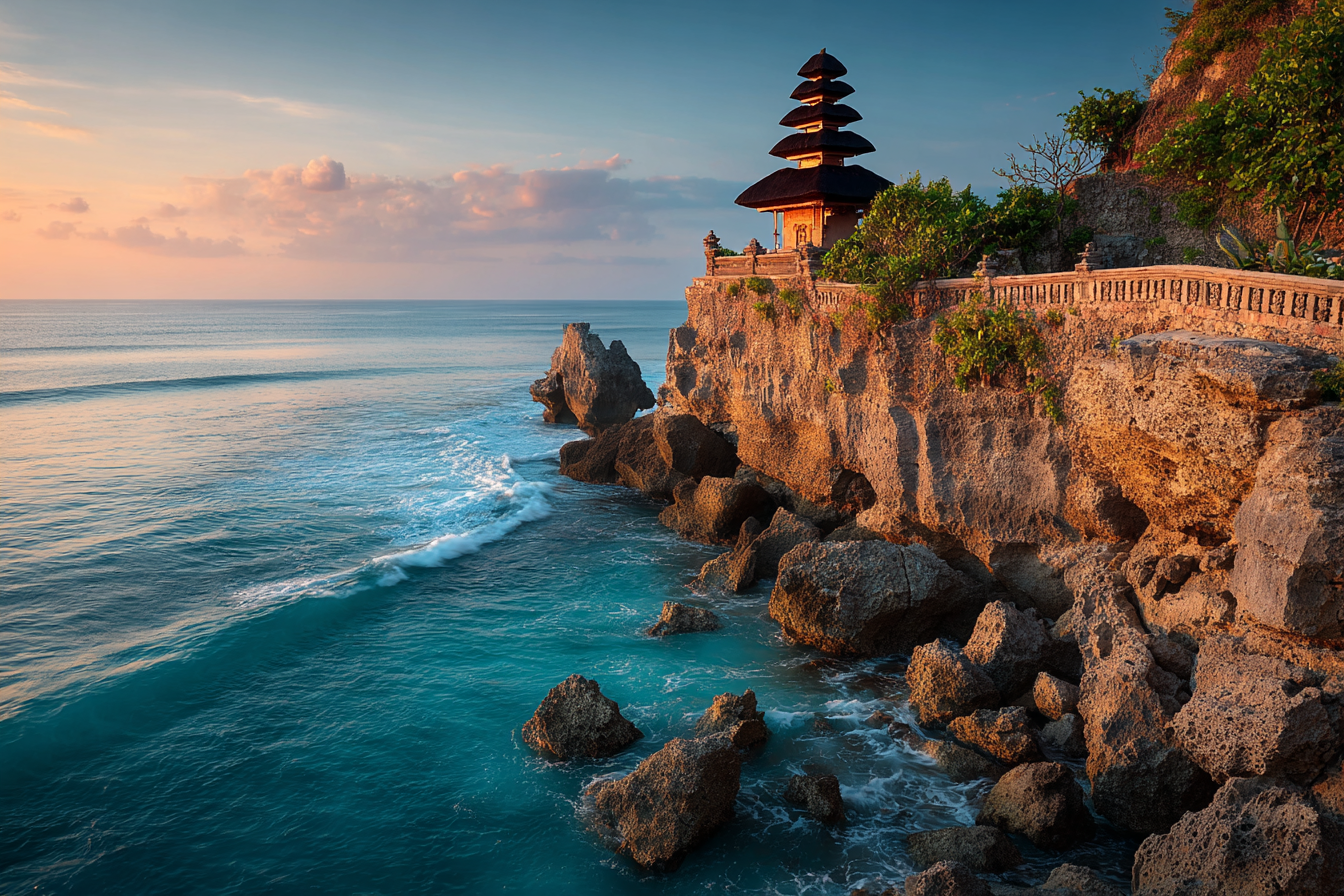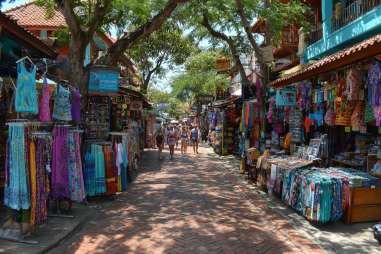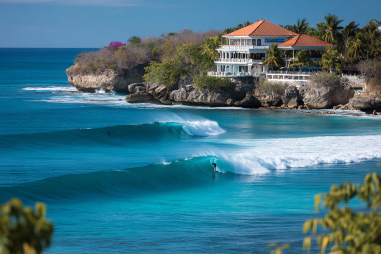Uluwatu is a spectacular coastal region located on the southern tip of Bali, Indonesia. Known for its dramatic cliffs, pristine beaches, and vibrant cultural scene, it offers a unique blend of natural beauty and rich heritage. Whether you’re a surfer chasing world-class waves, a traveler seeking breathtaking sunsets, or someone eager to dive into Balinese culture, Uluwatu has something for everyone. This guide will walk you through everything you need to know before you embark on your Uluwatu adventure, including how to get there, the best times to visit, top attractions, accommodation choices, local cuisine, cultural experiences, and practical travel tips.
How to Get to Uluwatu
Getting to Uluwatu is straightforward, with several options depending on your starting point and travel preferences. Most travelers arrive via Ngurah Rai International Airport (Denpasar Airport), which is Bali’s main gateway. From there, Uluwatu is about a 45-minute to one-hour drive southwest, depending on traffic.
Here are some common ways to reach Uluwatu:
- Taxi or Private Transfer: The most convenient option. You can arrange a pre-booked private transfer or grab a taxi from the airport. Prices are generally reasonable and the drivers are familiar with the roads to Uluwatu.
- Ride-Hailing Apps: Services like Grab and Gojek operate in Bali and can be used for trips to Uluwatu, although availability near the airport might be limited.
- Car or Scooter Rental: For those comfortable with Bali’s traffic and driving conditions, renting a scooter or car offers flexibility to explore Uluwatu and surrounding areas at your own pace.
Once in Uluwatu, it’s easy to get around by scooter, taxi, or even bicycle for shorter distances.
Best Time to Visit
The best time to visit Uluwatu largely depends on your preferences for weather and crowd levels. Bali experiences two main seasons: the dry season and the wet season.
- Dry Season (April to October): This is the most popular time to visit Uluwatu, with sunny days, lower humidity, and minimal rainfall. It’s ideal for beach activities, surfing, hiking along the cliffs, and sightseeing.
- Wet Season (November to March): While there are brief showers and occasional heavy rain, the wet season tends to be quieter with fewer tourists. It’s a good time for travelers who prefer a more relaxed atmosphere and don’t mind some rain.
Surf enthusiasts might also take into account the swell patterns, with July and August often bringing the best waves for surfing at Uluwatu’s famous breaks.
Top Attractions in Uluwatu
Uluwatu’s stunning natural and cultural attractions draw visitors from all over the world. Here are some must-visit spots:
- Uluwatu Temple (Pura Luhur Uluwatu): Perched on a steep cliff 70 meters above the Indian Ocean, this iconic Hindu sea temple offers jaw-dropping views and spiritual ambiance. It’s also famous for its traditional Kecak dance performances at sunset.
- Pandawa Beach: A beautiful white sand beach sheltered by limestone cliffs, perfect for swimming, sunbathing, and water sports.
- Bingin Beach: A favorite surf spot with a laid-back vibe packed with beach cafes and stunning sunset views.
- Suluban Beach (Blue Point): Known for its sea caves and excellent surf breaks, this beach offers a unique experience exploring natural rock formations.
- Garuda Wisnu Kencana Cultural Park: Although technically just outside Uluwatu, this cultural park features enormous statues, traditional performances, and sprawling grounds dedicated to Balinese mythology.
Accommodation Options
Uluwatu caters to a wide range of travelers offering accommodations from luxury resorts to budget hostels. Some popular choices include:
- Luxury Resorts and Villas: High-end travelers can enjoy cliff-top resorts with infinity pools, private villas with ocean views, and world-class amenities. Many resorts also offer spa treatments and yoga retreats.
- Mid-Range Hotels: Comfortable and affordable hotels are abundant, providing great value and good access to the main attractions.
- Budget Hostels and Homestays: Budget-conscious travelers can find cozy hostels, guesthouses, and homestays that offer a chance to connect with locals and other travelers.
Booking in advance, especially during the peak dry season, is recommended to secure the best deals and preferred locations.
Local Dining and Cuisine
Uluwatu’s culinary scene is as diverse as its landscape, blending traditional Balinese flavors with international influences. Here are some dining highlights:
- Warungs: Small local eateries serving authentic Indonesian food such as Nasi Goreng (fried rice), Mie Goreng (fried noodles), and Satay (grilled skewers). These are affordable and perfect for a quick, tasty meal.
- Beach Clubs and Cafés: Trendy beach clubs and cafés offer fresh seafood, tropical cocktails, and western-style dishes with stunning sunset views.
- Fine Dining: Upscale restaurants in resorts and nearby areas showcase gourmet Indonesian and international cuisine, ideal for special occasions or a treat.
Don’t miss trying Balinese delicacies like Ayam Betutu (spiced chicken) or Lawar (a traditional meat and vegetable mix) to indulge in authentic local tastes.
Cultural Experiences and Events
Uluwatu is rich in cultural heritage and offers many opportunities to experience Balinese traditions firsthand. Here are some highlights:
- Kecak Dance at Uluwatu Temple: Witness the mesmerizing fire-and-chants traditional dance performed during sunset at the temple. It tells stories from the Ramayana epic and is a must-see cultural performance.
- Temple Visits: Besides Uluwatu Temple, local smaller temples are scattered around offering serene spots for reflection and insight into Balinese Hinduism.
- Traditional Festivals: Timing your visit alongside local festivals can enhance your cultural immersion. Nyepi Day (Balinese Day of Silence) and Galungan are important celebrations celebrated with ritual dances and ceremonies.
- Workshops and Classes: Many places offer classes on Balinese cooking, traditional crafts, or yoga, allowing travelers to engage deeper with local culture.
Safety and Travel Tips
Uluwatu is generally safe for travelers, but keeping a few practical tips in mind will ensure a smooth trip:
- Watch for Strong Currents: Many beaches have strong currents and waves, especially popular surfing spots, so always heed warning signs and ask local advice before swimming.
- Respect Local Customs: Dress modestly when visiting temples, and remove shoes where required. Balinese culture is deeply spiritual, so be mindful of local practices.
- Stay Hydrated and Protected from Sun: The tropical climate can be intense. Use sunscreen, drink plenty of water, and wear hats or sunglasses.
- Use Reliable Transportation: Avoid unlicensed taxis and always negotiate fares upfront if using private drivers or scooters.
- Keep Valuables Secure: Petty theft can occur, so carry only what you need and keep your belongings in sight.
Additionally, it’s a good idea to have travel insurance that covers activities like surfing or hiking and to stay updated on local health advisories.
Planning Your Trip to Uluwatu
Uluwatu is an unforgettable destination blending breathtaking自然 beauty, vibrant culture, and a laid-back atmosphere. From cliffside temples and world-class surf breaks to delicious local cuisine and warm Balinese hospitality, it offers something special for every traveler. By planning ahead and considering weather, accommodation, dining, and cultural experiences, you can make the most out of your trip. Whether you’re chasing epic waves, exploring historic landmarks, or simply relaxing by the beach, Uluwatu’s charm will leave a lasting impression.
For more detailed travel resources, consider checking official Bali tourism websites, local travel blogs, and recent traveler reviews to stay informed on the latest updates and insider tips.







